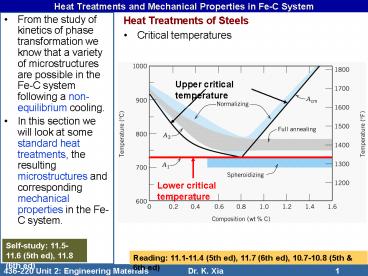Heat Treatments and Mechanical Properties in FeC System PowerPoint PPT Presentation
1 / 11
Title: Heat Treatments and Mechanical Properties in FeC System
1
Heat Treatments and Mechanical Properties in Fe-C
System
- From the study of kinetics of phase
transformation we know that a variety of
microstructures are possible in the Fe-C system
following a non-equilibrium cooling. - In this section we will look at some standard
heat treatments, the resulting microstructures
and corresponding mechanical properties in the
Fe-C system.
- Heat Treatments of Steels
- Critical temperatures
Upper critical temperature
Lower critical temperature
Self-study 11.5-11.6 (5th ed), 11.8 (6th ed)
Reading 11.1-11.4 (5th ed), 11.7 (6th ed),
10.7-10.8 (5th 6th ed)
2
Heat Treatments and Mechanical Properties in Fe-C
System
- Normalising
- original microstructure deformed with usually
large, uneven-sized and irregular-shaped grains
of pearlite and proeutectoid phase (if present) - treatment heating to above the upper critical
temperature, holding for sufficient time to
obtain 100 austenite (austenitising), and
cooling in air to room temperature - resulting microstructure fine grained pearlite
(with fine lamellae) plus any proeutectoid phase
that may be present
- Full annealing
- original microstructure anything that is not
soft enough - treatment heating to above the upper critical
temperatures for hypoeutectoid alloys, holding
for sufficient time for all pearlite to become
austenite, furnace cooling (thus very slowly) to
room temperature - resulting microstructure pearlite with coarse
lamellae plus any proeutectoid phase that may
exist - such a microstructure is soft and ductile
and thus amenable to further forming and machining
Annealing is primarily for sofening and cooling
very slowly is the key. Normalising may harden
or soften steels depending on the history of the
treatment.
3
Heat Treatments and Mechanical Properties in Fe-C
System
4
Heat Treatments and Mechanical Properties in Fe-C
System
- Spheroidising
- original microstructure pearlite that are too
hard even after annealing - treatment heating to just under the eutectoid
temperature and holding for long hours - resulting microstructure spheroidised Fe3C
particles (of the order of 5 µm) in a matrix of
a, a much softer and ductile microstructure
Spheroidised cementite
5
Heat Treatments and Mechanical Properties in Fe-C
System
- Quenching
- heating to the single g region to austenitise
100 austenite achieved - quenching in cold medium (e.g. water) to achieve
rapid cooling - martensite is the intended product
(microstructure) although 100 M is often not
possible as the interior of the sample may not
undergo the same rapid cooling as the surface - the material after quenching is very hard but
brittle (due to M) and thus usually not usable in
engineering applications
- Tempering of M
- original microstructure M
- Heating to 250-650C, holding for a period of
time, and cooling to room temperature - resulting microstructure tempered martensite
extremely small Fe3C particles (of the order of
0.1 µm) uniformly distributed in a (in the
spheroidite, the Fe3C particles are much coarser) - Tempered M is as strong and hard as M, but much
tougher and with improved ductility - this
structure is desirable and consequently, M is
almost always tempered.
6
Heat Treatments and Mechanical Properties in Fe-C
System
- Microstructure of tempered martensite
- Fe3C particles are about one order of magnitude
finer compared to those in the spheroidite
7
Heat Treatments and Mechanical Properties in Fe-C
System
Reheat
8
Heat Treatments and Mechanical Properties in Fe-C
System
- Mechanical properties
- Which microstructure to have?
- Depending on mechanical properties required
- Ingredient phases of a microstructure
- a soft and ductile
- Fe3C hard and brittle
- Martensite extremely hard and brittle
- Mechanical properties depend on the amount,
shape, size and distribution of these phases,
i.e. microstructures - Various microstructures can be obtrained through
different heat treatments
Processing
Microstructure
Property
9
Heat Treatments and Mechanical Properties in Fe-C
System
- Effect of amount of cementite
Eutectoid composition
Strength increases with C
Ductility and toughness decrease with C
10
Heat Treatments and Mechanical Properties in Fe-C
System
- Effect of shape and size of cementite
Strength increases with decreasing thickness of
lamellae in pearlite
ductility is higher in spheroidite
ductility decreases with decreasing thickness of
lamellae in pearlite
Strength is lower in spheroidite
11
Heat Treatments and Mechanical Properties in Fe-C
System
- Effect of martensite and tempered martensite
Hardness M gt Tempered M gt fine P gt coarse P gt
spheroidite
What about ductility and toughness?

